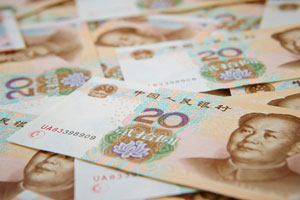The Yuan as a Global Reserve Currency?

China accounted for 17 percent of the world’s gross domestic product in 2014.1 It is also the world’s largest saver,2 but it is almost a closed economy in terms of capital flows.
China has undertaken various economic reforms in recent years. These reforms include deepening its capital markets and increasing the importance of the yuan in the global economy.3 Some commentators have argued that the yuan may become a global reserve currency in the near future, given these reforms and China’s rising importance in world trade. In fact, China’s recent move to devalue the yuan was seen by some as a way to let the market play a bigger role in deciding the yuan’s value without jeopardizing the potential of the International Monetary Fund to declare it an official reserve currency.4 How likely is this?
In 2013, the yuan became the ninth most actively traded currency in the world, with 2.2 percent of the over-the-counter foreign exchange turnover in April 2013 in yuan. This represents a marked increase in trading activity: In 2001, the yuan was barely traded at all, and in 2004 only 0.1 percent of the total was in the Chinese currency.5,6
However, whether the importance of the yuan will match the global importance of the Chinese economy will depend on three factors:
- Whether it is used to denominate international transactions
- The degree of China’s financial development
- Whether it is held by foreign central banks as a reserve currency7
China has advanced in each of these three areas:
- A total of 9.95 trillion yuan ($1.6 trillion) of cross-border payments were made in yuan last year, according to the People's Bank of China.
- The government has undertaken reforms to eliminate capital controls and improve the banking system.
- At least 40 central banks are holding the yuan, increasing its importance as a reserve currency, according to Standard Chartered.8
However, there is still a long way to go. There are still doubts among international financial market traders on the security of the yuan as a store of value. In this sense, the main areas in which the government should work are in improving transparency and stability to increase the confidence of international investors.
Notes and References
1] “World Development Indicators,” World Bank, July 28, 2015.
2 Dobbs, Richard; Leung, Nick; and Lund, Susan. “China’s Rising Stature in Global Finance,” McKinsey Quarterly, July 2013.
3 Ruan, Victoria. “Beijing Approves Blueprint for Capital Market Reform,” South China Morning Post, May 19, 2015.
4 Wei, Lingling. “China Moves to Devalue Yuan,” The Wall Street Journal, Aug. 11, 2015.
5 “Triennial Central Bank Survey: Foreign Exchange Turnover in April 2013: Preliminary Global Results,” Monetary and Economic Department, Bank for International Settlements, September 2013.
6 The total sum of percentage shares of all currencies is 200 percent instead of 100 percent, because two currencies are involved in each transaction.
7 Prasad, Eswar; and Ye, Lei. “Will the Renminbi Rule?” Finance and Development, March 2012, Vol. 49, No. 1, pp. 26-9.
8 Yu, Jeanny. “Central Banks’ Investment in Yuan Puts Currency Nearer Reserve Status,” South China Morning Post, April 17, 2014.
Additional Resources
- On the Economy: How International Trade Affects the U.S. Labor Market
- On the Economy: Why Does the U.S. Have Such a Large Trade Deficit with China?
- On the Economy: Using Exchange Rates as Monetary Policy Instruments
Citation
Ana Maria Santacreu, ldquoThe Yuan as a Global Reserve Currency?,rdquo St. Louis Fed On the Economy, Aug. 31, 2015.
This blog offers commentary, analysis and data from our economists and experts. Views expressed are not necessarily those of the St. Louis Fed or Federal Reserve System.
Email Us
All other blog-related questions


